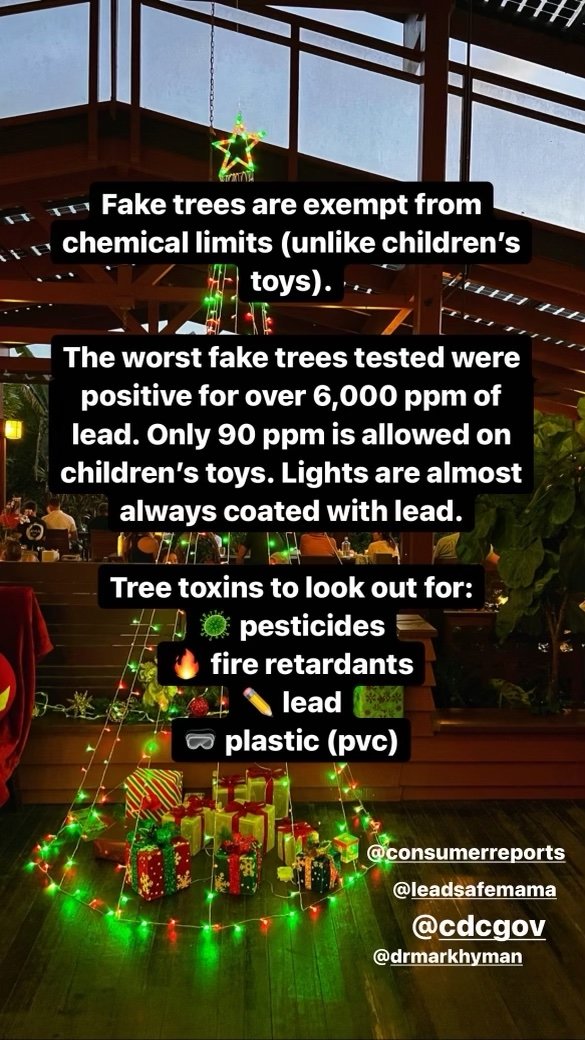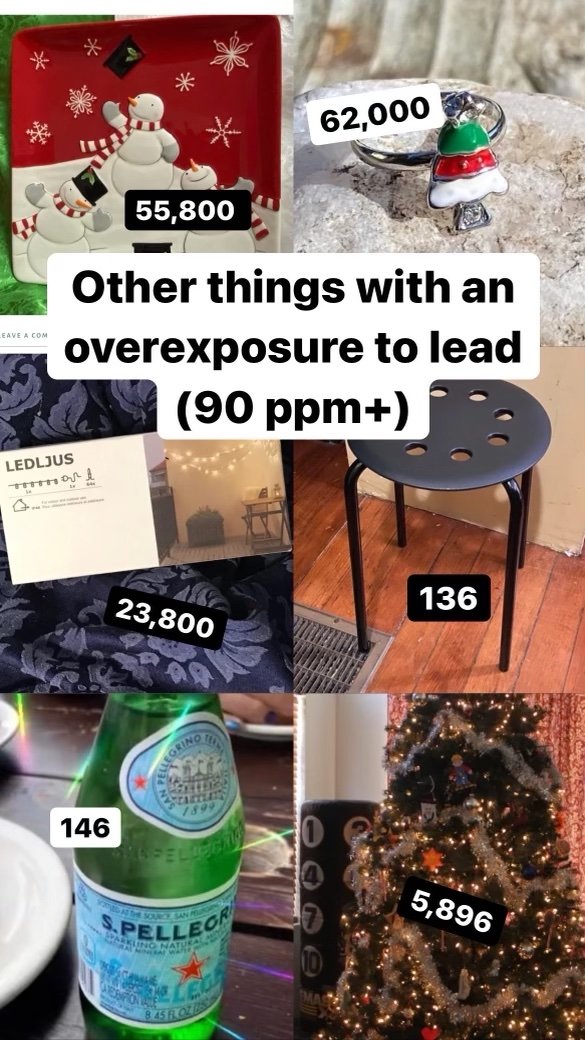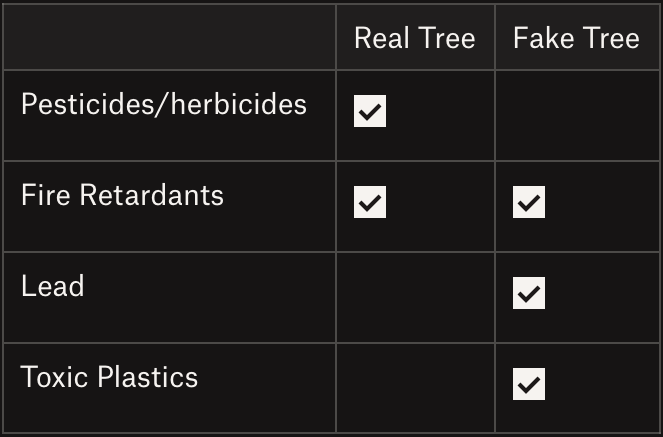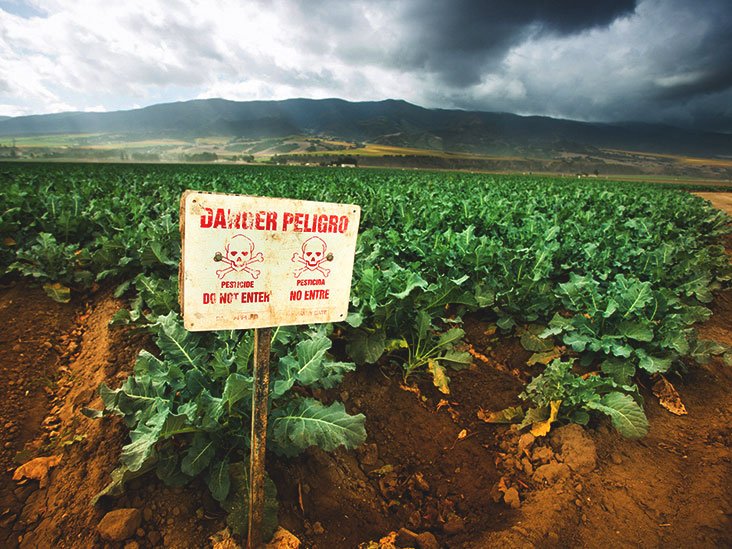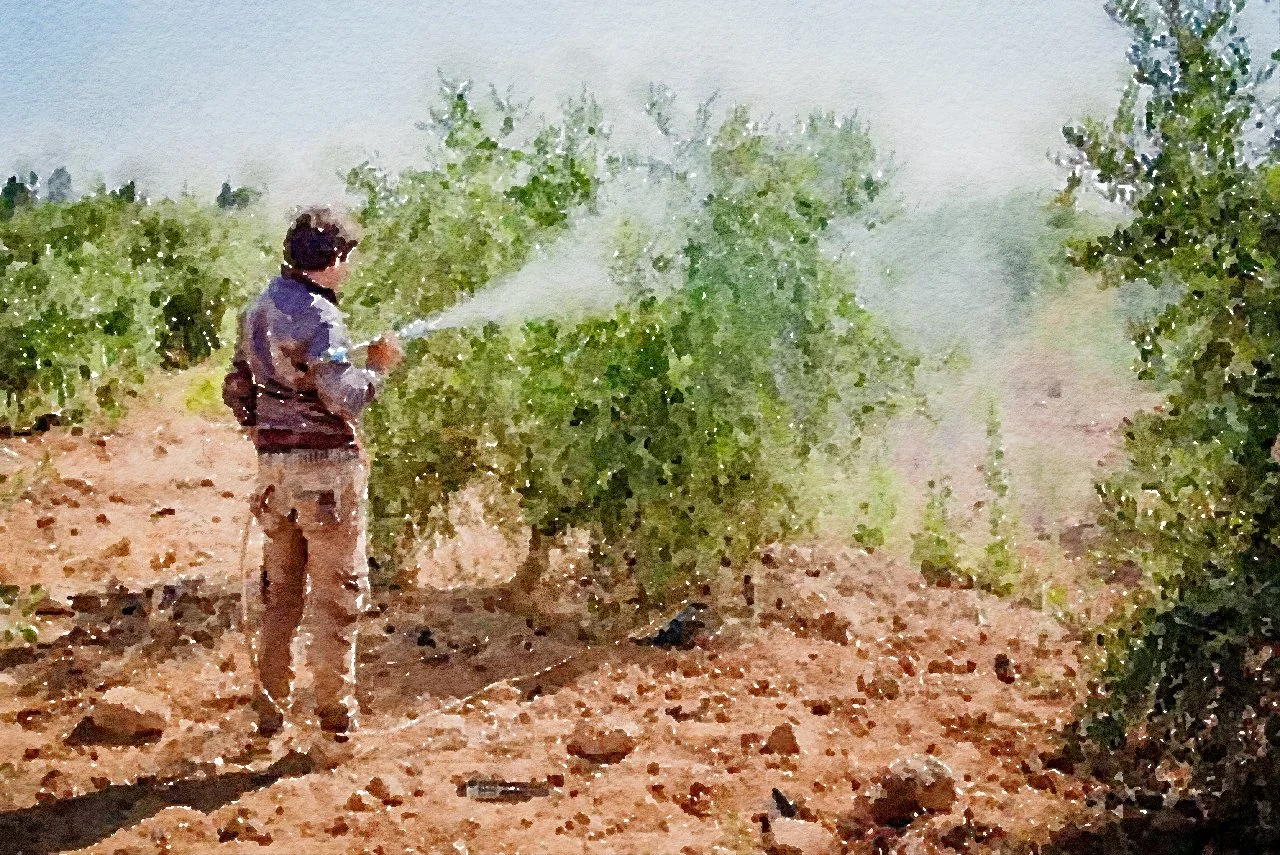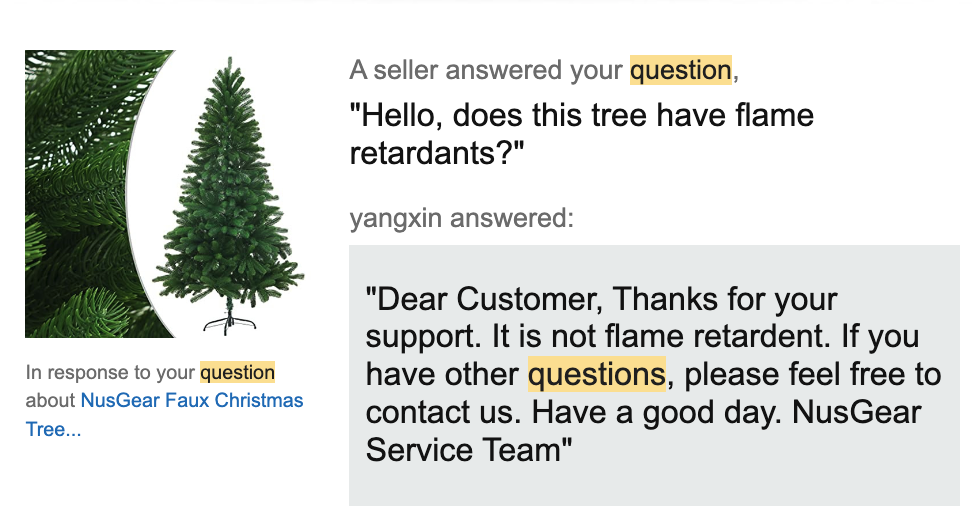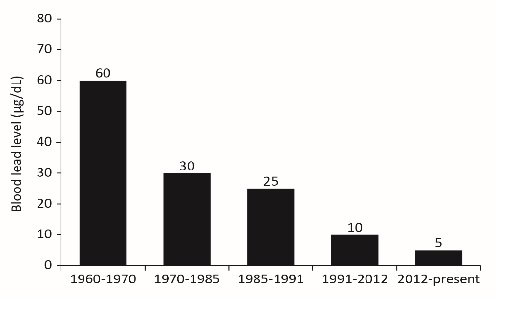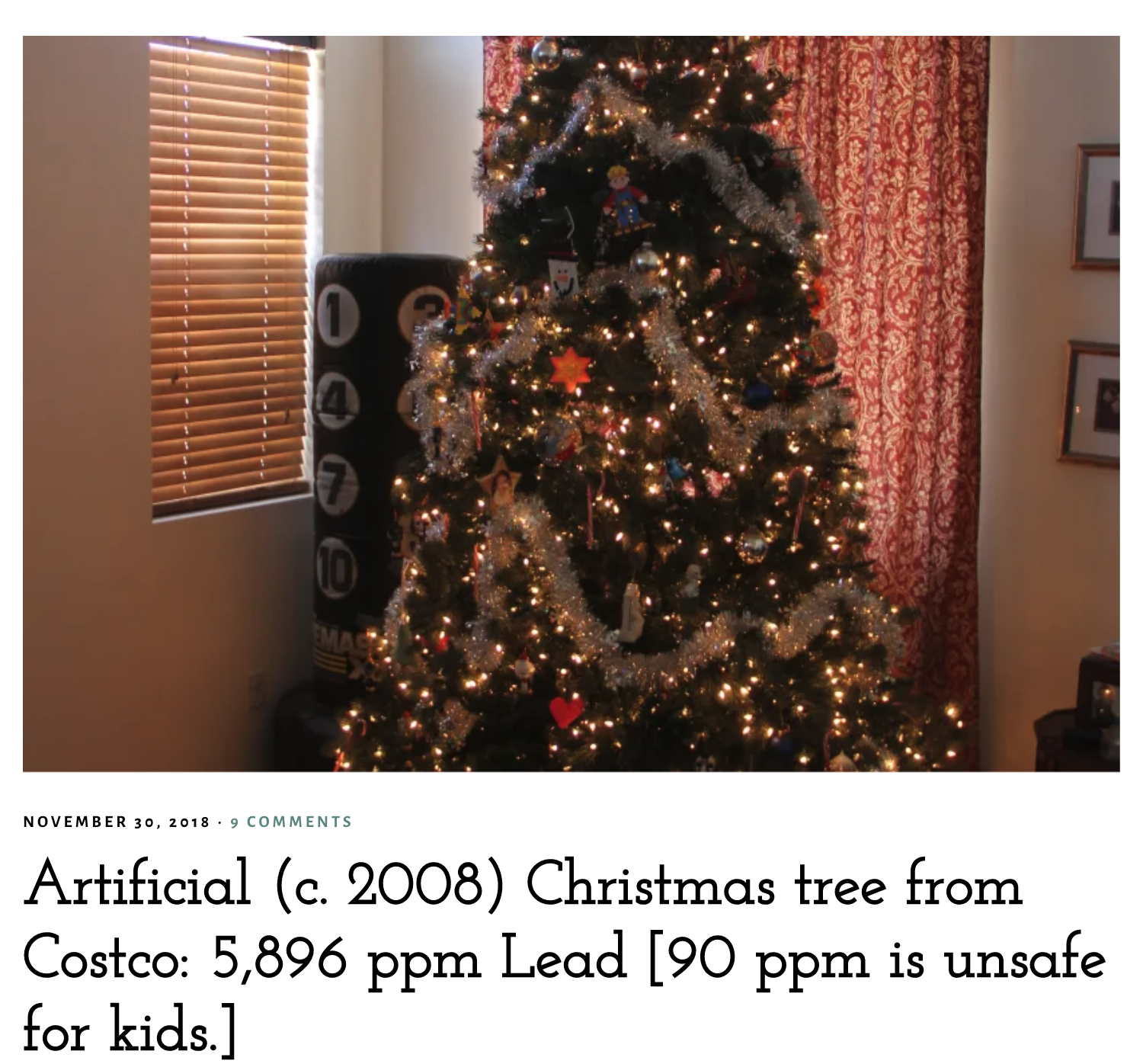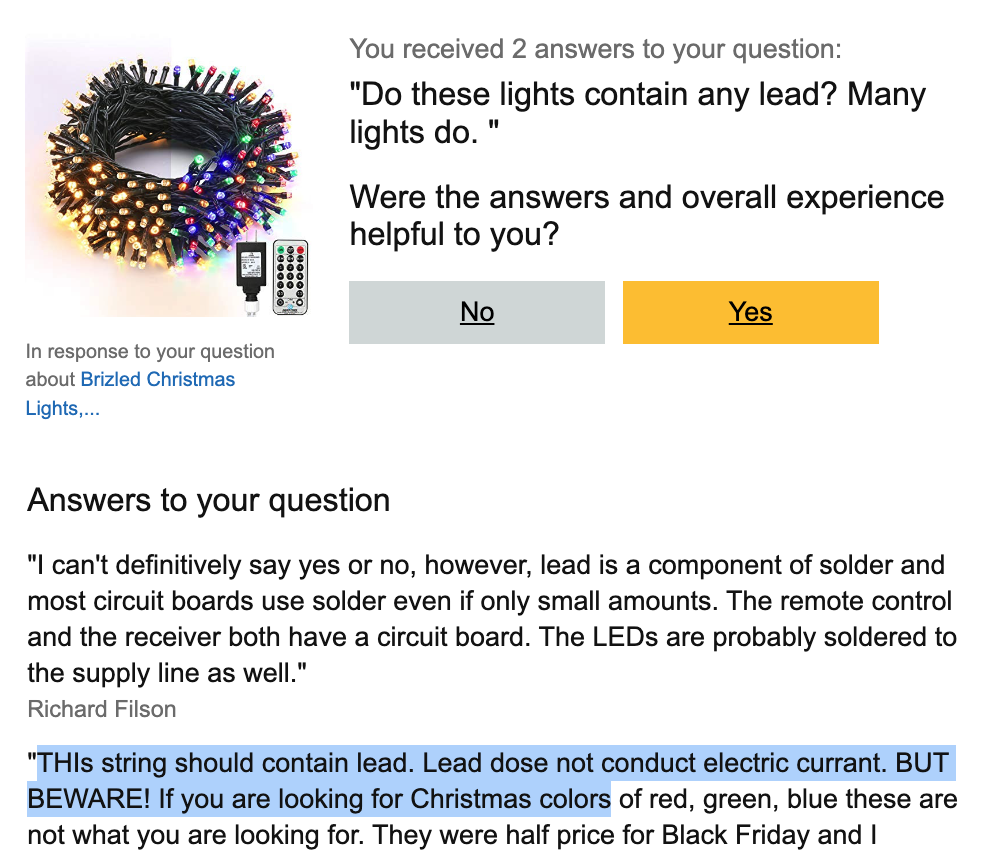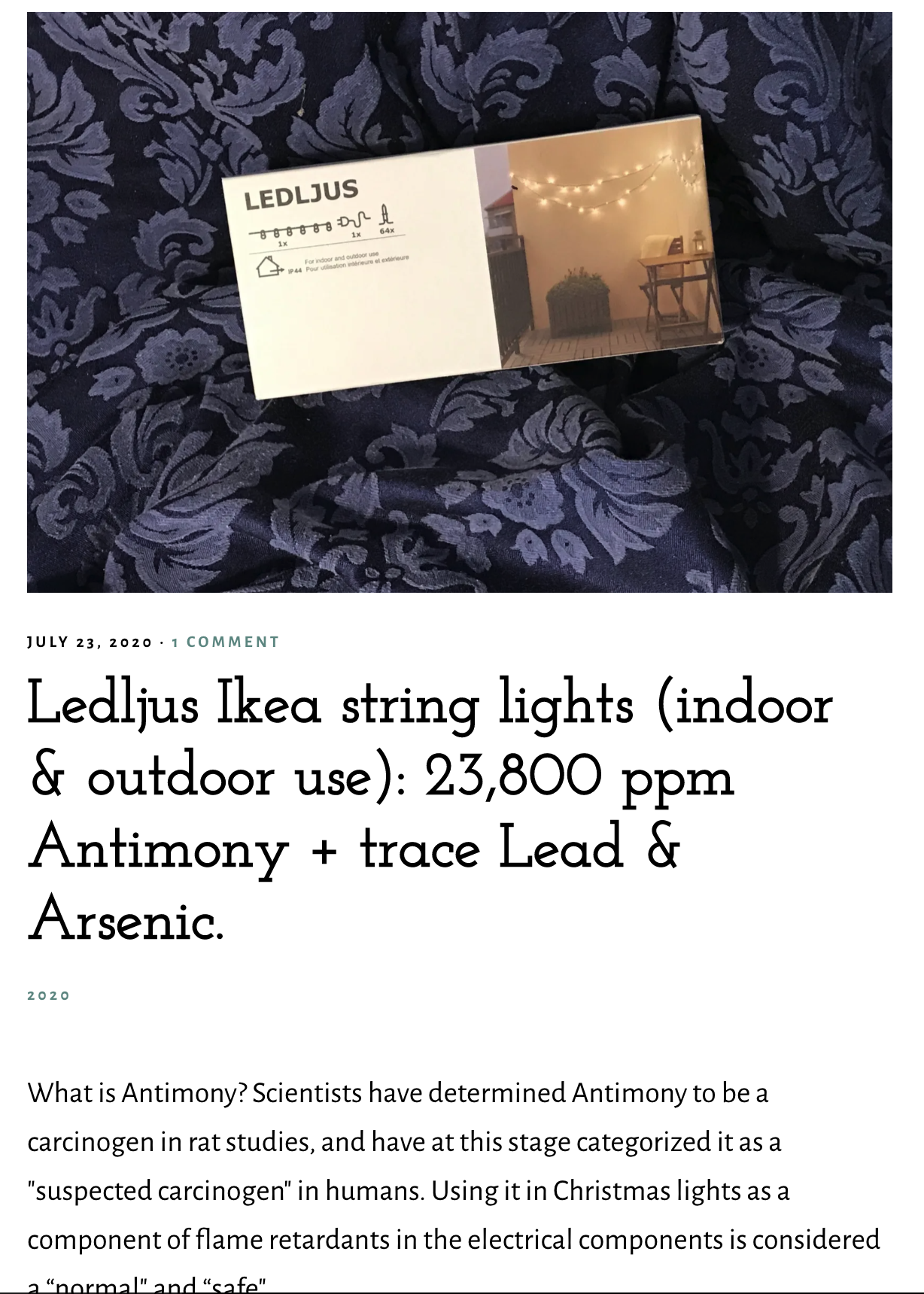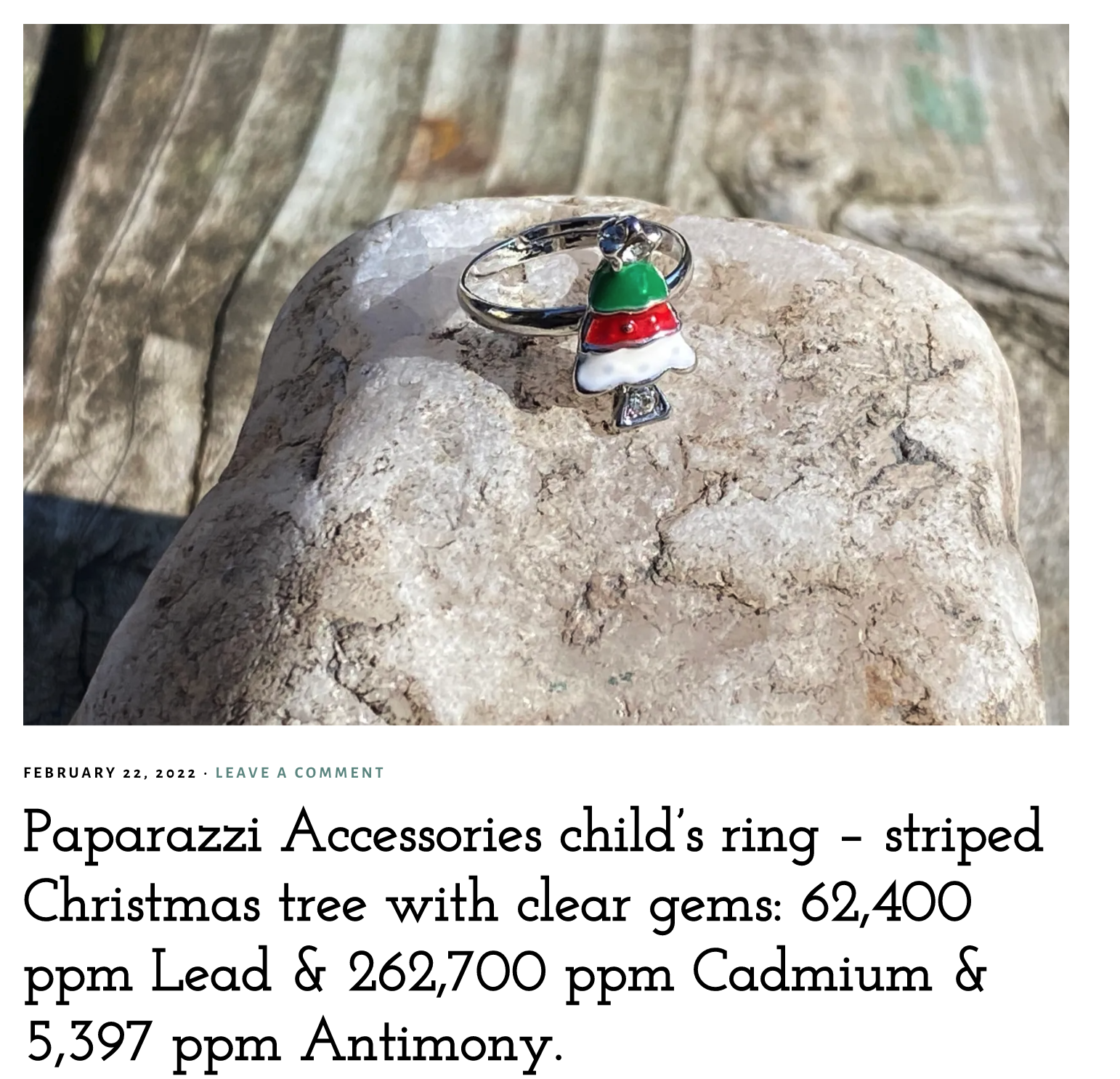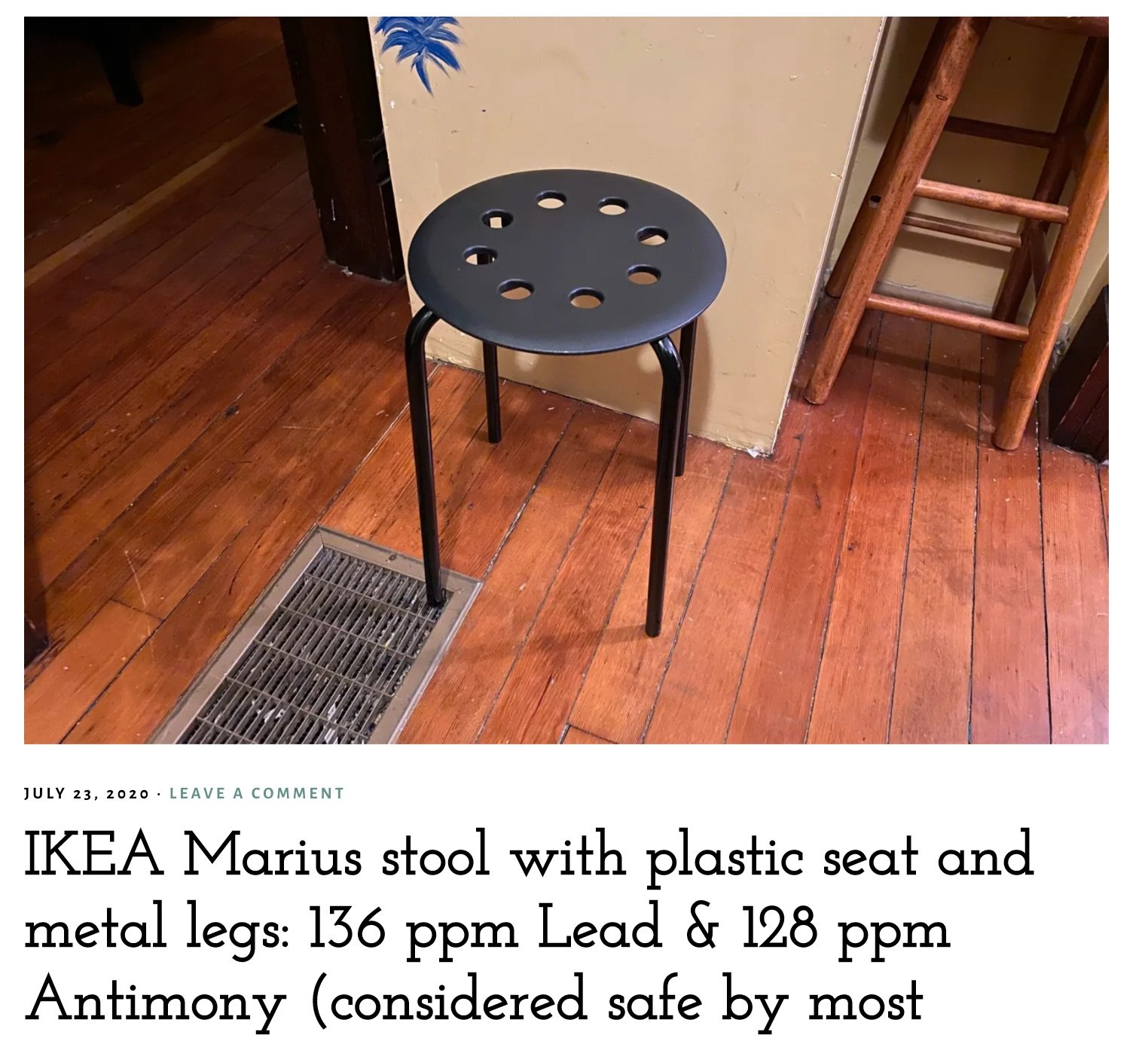Real vs Fake Tree??
It may seem like you can pick up a tree from any big store parking lot, but bringing home a non-toxic tree is trickier than it sounds.
The fake trees from Costco, 2008 were tested to contain 5,896 ppm Lead
90 ppm is unsafe for kids!
Even real trees are typically sprayed with pesticides and fire retardants, and most fake trees have the worst kinds of plastics and most likely contain lead. All of these are major problems for kids and pregnant women, (associated with impaired brain development, DNA malformation, and cancer), and are not meant to be touched by little hands. Not exactly what you want for a centerpiece of the family!
Simply put, fake trees are considered “decorative items” and exempt from laws limiting chemical exposure to kids.
At least be aware that you should have your child wash their hands after touching a christmas tree and its lights. (this just reduces the toxic burden, but awareness is priceless!)
The Biggest culprits to look out for:
Pesticides/herbicides (found on real trees)
Known to cause: birth defects, fetal death, attention and learning problems, cancer, microbiome damage, immunity impairment
Fire Retardants (found on real AND fake trees)
Linked to: DNA damage, infertility, hormone disruption, cancer, reduced IQ, damage to the immune system
Lead (found on fake trees)
Linked to brain damage, cancer, lower IQ, reproductive harm, even seizures and death in high cases.
PVC Plastics (found on fake trees)
Increase risk of cancer (liver, brain and lung), and known hormone disruptors (especially linked to smaller penises to babies exposed in utero, low sperm count, and ovary/egg damage)
If you have a young family, or are planning to have one, THESE are the years you have the most control over your children’s health, and can have the greatest potential impact. No other moment in their lives are they developing so fast (damages are never greater). And in this same time, they are literally ABSORBING their environment, (licking and touching everything), all before their immune and detox systems are fully up and running. No other moment can you cause a bigger impact on the health they develop for THE REST OF THEIR LIVES.
Best option: find an organic real tree
Plastic fake trees are detrimental to you AND the environment (and esp your children’s health).
Fake trees are harmful to indoor air quality, while a real tree is beneficial
Fake trees add to waste, cannot be recycled, and their chemicals accumulate in the environment.
Next best: Find the least toxic plastic tree (no lead, fire retardants, or PVC)
PE or PP (polyethylene or polypropylene) appear to be less toxic plastic than PVC (most common for fake trees).
The only fake tree I would buy: IKEA’s Tree! (no PVC, lead, or fire retardants)
Thank you Europe for your higher standards!
Seriously, where are all the non-toxic parents going to get plastic trees?? oh wait, they are just going all natural… duh.
The VINTERFINT, the only plastic tree I could find that has no PVC plastic, fire retardants, or lead.
#SimpleSolution: The best solution I’ve read includes skipping the artificial tree altogether and buy a potted living plant (any kind of plant – it doesn’t need to be an evergreen!] to use as a Christmas tree, and plant it in the yard each year after the holiday.
How many people buy real vs fake?
By far most americans have a fake tree (75% of homes with a christmas tree choose fake).
About half of those just reuse the old, but many still buy a new one each year
Every year, Americans buy about
33 Million real trees
24 Million fake trees (even though they are reusable)
Costs
A fake tree: $100-$1000, lasting 5-10+ years ($20-$100 per year, depending how long you keep it).
The older a plastic tree gets, the more it deteriorates, and the more chemicals that leach into your home.
Real tree: $100 per year
but what is your children’s health worth? (what do cancer and behavioral issues cost a family?)
My analysis
Pro Real Tree
Since our family is young, and in the most sensitive years to toxins, we made careful consideration to go with a real tree.
While pregnant, it is the MOST important time in your whole life to go organic EVERYTHING, including strange plastic things that our young babies will be touching, licking, and pulling on.
I just love the smell. I find the smell of plastic gross (for scientific AND health reasons).
My husband loves the idea of picking his own tree from an organic farm, ESPECIALLY if he gets to use a saw.
Pro Fake Tree
If I knew we were traveling for Christmas, I would consider a fake tree, because you shouldn’t leave a real tree unwatered for a week or more.
The Biggest Culprits to look out for (in detail):
Pesticides/herbicides (real trees)
Birth defects, fetal death, attention and learning problems, cancer, microbiome damage, immunity impairment
Fire Retardants (real AND fake trees)
DNA damage, reproductive issues, cancer
Lead (fake trees)
Linked to brain damage, cancer, lower IQ, reproductive harm, even seizures and death in high cases.
Toxic Plastics (fake trees)
Increase risk of cancer (liver, brain and lung), and known hormone disruptors (especially linked to smaller penises to babies exposed in utero, low sperm count, and ovary/egg damage)
Pesticides/Herbicides/Roundup
The reasons to go organic. At least, ask if/what/when they spray.
"Babies are most sensitive to the damaging effects of pesticides and other chemicals while in the womb," said Bill Freese, science director at the Center for Food Safety. "It is deplorable that EPA caved to the pesticide industry rather than demanding studies to investigate the potential for difenoconazole and over a dozen similar fungicides to disrupt the brain at this critical stage of development."
All the ”-cides” are invisible. And they are already all over our food. But that does not make it okay. Food Safety rules are constantly changing around chemicals sprayed on food/lawns/trees.
1972: back to JFK banning DDT, and STILL found in our children’s bloodstreams 50+ years later!
2000: The chemical, difenoconazole, was shown to cause cancer and hurt infant's brain and organs. It still has not been banned.
2015: Whole cities have banned spraying in parks where kids and pets play (thank you San Francisco!).
2021: major lawsuits, including $11 BILLION settlement for farmers getting cancer from using Roundup/glyphosate.
Laws are still changing significantly based on who is sitting in the president’s seat. Obama had some bills ready for banning roundup, but Trump reversed them. (Honestly, this is the kind of thing that gets me to vote! )
Fighting these toxic chemicals through lawsuits takes DECADES against big companies with deep pockets. BUT local petitions work!
Read Silent Spring for some motivation
Why pesticides are bad
In Short: Birth defects, fetal death, attention and learning problems, cancer, microbiome damage, immunity impairment
Pesticide exposure during pregnancy may lead to:
an increased risk of birth defects
low birth weight
and fetal death.
Exposure in childhood has been linked to attention and learning problems, as well as cancer.
Infants and children are more sensitive to the toxic effects of pesticides than adults.
Their brain, nervous system, and organs are still developing, and their immature liver and kidneys cannot remove toxins as well as adults.
Most pesticides are said to be active for only about a month or so, but research shows these chemicals get into the water cells of the plant and NEVER dissolve (forever building up in our water system).
They are often sprayed incorrectly. Most farmworkers speak spanish, but pesticide safety labels are often only printed in english.
Insecticides are designed to wreak havoc on an insect’s metabolism, but those metabolisms are very similar to the gut bugs lining our own microbiomes. Mainstream safety information does not recognize the microbiome, as if it does not exist. If it doesn’t kill you on the spot, authorities are not worried.
Different species of trees may use different chemicals (so there is not one chemical to be fought). We have to be diligent ourselves, avoiding any kind of spraying, while we (and our children’s children) wait for the “industry” to attack one chemical at a time (while replacements wait in the wings).
For example, Douglas Fir tends to get a fungus problem called Swiss needle cast (SNC). Other species require different categories of chemicals.
Organic Trees
Here is a list of organic Christmas tree farms in different states.
We found a great, small tree farm that doesn’t use any pesticides (they were not on the list above). They aren’t certified organic but they never spray their trees with anything.
Fire Retardants (FR)
(these should be called mental retardants… they actually retard your mental capacity).
Fire retardants don’t actually GIVE all that much protection. They just prevents an initial spark. More harm comes from the chemical than the protection it gives.
Why are FR chemicals so bad?
In short: DNA damage, infertility, hormone disruption, cancer, reduced IQ, damage to the immune system
FR chemicals cause damage to DNA on an epigenetic scale (damaging genes for all the generations that follow).
particular to altering sperm genes (including mom’s and daughter’s future sons)
Children of highly exposed mothers have higher rates of:
Reproductive problems
Adult sons with 3x higher likelihood of urinary problems
Daughters with 4x higher odds for spontaneous abortions. (the mothers themselves did not have this risk. But a generation later, the cause becomes almost impossible to pin down as an individual! Who would think to blame their MOM’s chemical exposure?!)
Daughters speeding up puberty by over a year earlier
cause reproductive abnormalities
increase chronic disease susceptibility
metabolic disorders, mental health disorders, and cancer
known as endocrine disruptors (disrupt hormones, particularly in the thyroid, the brain of our hormones)
A group of farmers in 1976 accidentally fed their cattle FR chemicals, and the people who ate the meat had a higher prevalence of:
acne, skin darkening, nail discoloration, slowed healing, nausea, headache, blurred vision, dizziness, depression, fatigue, anxiety, weakness, paresthesia, loss of balance, joint, back, and leg pain, dry skin and increased sweating
the animals themselves had problems reproducing
Highly exposed members have increased risk of cancers
in the digestive tract, esophagus, stomach, liver, breast and pancreas
Pretty much every manufacturer of fake trees I can find adds Fire Retardant (FR) chemicals. And they proudly state it. (Ikea is the only one who tries not to, and they only add if local regulations require it.)
Fire Retardant Timeline:
1972: The US started adding FR to children’s pajamas when house fires were more common. And majority of home fires are from kitchen fires. (please get a mini home extinguisher just in case!)
Fire retardants were gradually added also into furniture, mattresses, and yes, christmas trees.
1977, scientists found the chemicals used to treat fabrics to reduce fire affected children’s DNA, and banned the most popular FR chemical at the time, brominated tris, in kids clothes. They found:
it damages DNA, was shown to cause cancer (For 5 years, children were exposed to this carcinogen in their sleep).
that it was, in fact, absorbed through the skin (many chemical companies claimed the product just washed off and could not be absorbed).
But there is always a substitute chemical. Brominated tris was replaced with chlorinated tris… and guess what? It was found to affect DNA, too.
1996: The CPSC (consumer product safety) were still finding DNA damage in children, and changed regulations to allow for sleepwear to be made from natural fibers, like cotton, as long as the pajamas were tight-fitting
Canada requires wash instructions that explain fabric softener increases a fabric’s flammability because it separates the fibers, giving them that soft and fluffy feel.
In terms of FR effectiveness in controlling fires,
Some fire retardants sprayed on trees INCREASES their chance of catching flame by drying out the tree faster. It is only an assumption that all flame-retardants are effective on Christmas trees. This has never been proven.
Fire retardants don’t actually GIVE all that much protection. They just prevents an initial spark (but WILL catch fire).
This protection washes away in about 7 washes. Hand-me-down clothes are the best, for this reason!
You can get natural fire protection from: Wool, nylon, and silk
Real Christmas trees catch fire about 3x as often as fake trees (though this rate is still very low)
There is a reported average of 160 tree home fires per year, (only 0.00093% of trees are ignited in home fires).
It is very difficult to ignite a tree if it is properly watered.
While not all that effective, the FR chemicals DO cause known harm to our bodies.
More harm comes from the chemical than the protection it gives. The damage from the FR (fire retardants) to our DNA is WAY worse than its potential to protect us from an unlikely fire.
Terms to know the difference:
Flame resistant due to the structure of the fabrics and the way they're woven (wool, nylon, and silk)
Flame Retardant Fabric – chemically treated fabrics (found to harm your baby’s DNA)
These fabrics are likely to also include other chemicals like:
BPA (a hormone disruptor)
PTFE (the toxic chemical found in Teflon)
Dyes
Mold, mildew and wrinkling resistors during shipment (This is why it’s so important to wash clothes before wearing them.)
As consumers, we’re kept in the dark of how our products are made. Best we can do is purchase less often, and of higher quality products with NO spraying of chemicals at all. So yes, organic clothing is as important as organic food and trees! Our skin sometimes absorbs better than ingestion (Vitamin C and D are prime examples).
Real ways to reduce house fires:
Keep a fire extinguisher in your kitchen ($25 on amazon!)
Do not use fabric softener (separates the fibers, which makes it soft, but increases the fabric’s flammability)
Turn lights off at night. Even an artificial tree can catch fire as a result of tree lights.
If you have a real tree, make sure it is watered. House fires from trees were basically dry for weeks.
Pick the freshest looking tree farm (that cut trees in the last few weeks if possible).
Organic trees are typically cut more recently (to have less exposure to elements), and may still be in the ground! (especially if cutting the tree yourself!)
Wait until December 1st or later to get your real tree, and keep for 10-14 days max (others say 4 weeks).
Dispose of your tree soon after the holidays. (Find a recycling/mulching program in your area).
Most fires are sparked by electrical equipment malfunctioning.
Plug lights DIRECTLY into the wall, or with an electric outlet RATED for higher capacities (the wires literally BURN from too much use and you pay for the extra insulation).
Get LED lights, especially solar powered ones
Chemical Rules
In the U.S., no protection agencies have the ability to get the manufacturers to show that their flame retardant chemicals are safe. They continue to be used without consideration of their side effects.
Just some flame retardants that were found to have serious long term effects only AFTER being used heavily.
PBBs
PCBs
brominated tris
Halon
asbestos
PBDEs
AKA, all of these had no health studies, so the consumer (we, our families), were/are the guinea pigs, and have to PROVE toxicity by enough children getting sufficiently sick to get someone’s attention. (Chemicals are innocent until proven guilty, by unmistakingly HARMING your children).
Most chemical companies do not have to show all of the chemicals in their products (called propietary, or family secret recipes), and PROTECTED by confidential business information regulations (the chemicals are the only things that seem to be protected here, not our children).
Once chemicals are banned, there is no way to track down the items already in our homes.
For example, pentaBDE is no longer allowed to be MADE, but still present in furniture, carpet padding, electronics, cars, and seating in mass transportation (planes, trains, buses).
PBDEs can be found as far away as polar ice caps and deep in our oceans, showing how far their spread can reach unintentionally.
Any banned chemicals should be identified and disposed of responsibly. But who has ever heard of PBDE’s, or that they are in your sofa cushions or airplane seats?!
Lead
Linked to brain damage, cancer, and lower IQ.
There is NO SAFE limit for the amount of lead exposure. Instead, health officials say to just avoid it. The “limits” set by regulations are literally arbitrary, as no one can prove a “safe” level. And these levels have changed dramatically in the last 70 years, to the point our blood level meters are not accurate enough to warn of levels of harm.
Why Lead is so bad
Lead poisoning is one of the most common and preventable pediatric health problems in the United States today.
26% (more than 1/4) of all american children ages 1 to 5 have an OVEREXPOSURE of lead at 5-10 ug/dL (which corresponds to IQ loss of 7 points). (for black communities, HALF are over-exposed to lead).
This means more than a million children each year are robbed of the intellectual potential they were born with.
A “safe” level has not been established, as all levels show harm, but action has to be taken to reduce SOME things, like levels of lead in paint and children’s toys.
Few children still suffer from the most serious effects of lead poisoning such as seizures, comas or death. (this was common before 1970’s).
Lead has been shown to harm virtually every organ and/or system in the body, especially children.
Lead damages
the nervous system
the kidneys
the body’s ability to regulate vitamin D.
At lower levels of exposure, a child can suffer from IRREVERSIBLE:
Developmental delay
Lower IQ: As lead in your blood goes up, IQ goes down. And, paradoxically, the first few micrograms of lead are the most damaging.
hyperactivity
learning disabilities
behavioral problems
impaired hearing
stunted growth
Long-term, low level exposure of lead in adults may be associated with
weakness in fingers, wrists, ankles, and muscles
headaches
fatigue
small increases in blood pressure
damaged nerve and renal function
For men, can damage the organs responsible for sperm production
Exposure to lead very early in life can re-program genes that make it harder for your children to manage stresses later in life.
Young children are more likely to absorb lead just by being more curious of their environment.
Children put their toys, hands and other objects in their mouths
May chew on painted windowsills, railings, furniture and toys,
They spend a lot of time on the floor where sources of lead are likely to be found.
A child’s developing brain and nervous system are more susceptible to damage from lead since the blood-brain barrier is not complete until 3 years old.
In those 3 years, there is extensive neuron development which cannot be repaired if damaged at such a young state.
The nervous system is the main target for lead toxicity in both adults and children.
Those with diabetes have a higher risk of problems associated with the kidney and lead exposure.
Exposures
Lead is a common toxin found in homes, especially if made in the 1970’s or earlier. Even if not in the paint, it is commonly found in the water or soil surrounding an old home.
Cheap home remedies just cover up the paint. But any kind of deterioration (or scratching/peeling of paint) means exposure.
Even when “covered” in newer concealment paint, lead collects in the dust on the floor (where our children play).
Electrical lights are still lined with lead.
Environmental Lights makes lead free Christmas lights. The lights are much more expensive than traditional lights but in my mind it is worth it. If you aren’t able to purchase lead free lights then make sure you wash your hands after touching them and do not let children touch them.
Many might say ROHS compliant, which does allow lead below 1,000ppm. This is still 100x higher than that allowed for expected use with children.
Most PVC plastic also contains lead (lead is a stabilizer in PVC).
Testing for Lead
Lead is tested via blood test, and covered by insurance, you just have to ask for it. You can also test your home (typically $400+ for a professional, or $20 in home test kits).
Who should get tested
Your child will be tested for lead around 1 and 1.5 years old by their pediatrician, via toe prick.
If they register “high” (above 3.3), they will be recommended to go a lab for a larger draw from the vein in their arm, for a more accurate reading.
My son had levels around 3.8 from the toe prick, so I tested my blood level rather than holding a screaming toddler with large needle. If his level was much higher, or mine came back high, I would have had him checked too. Since he was only 18 months old, and we spent most of our time together, I assumed we would be similar.
For small kiddos, if further tests are needed, a pediatric phlebotomist at a children’s hospital is recommended, for their skills working with small babies, rather than a typical corner testing lab. This should be covered by insurance; just ask your doctor to call a lead blood (BLL) test ordered in to the children’s hospital for you.
If a woman is pregnant, she should request to be tested for lead. This is not a typical request, but covered by insurance, especially if cause for concern (like living in an older home). Lead is ESPECIALLY harmful to developing babies in the womb.
If you move to a new home, and have or want kids some day in that home, you should get tested (preferably before, and a month or so after you move, so you can track if the lead came from the new home or old).
Request a lower testing threshold is for Blood Lead Level tests.
Most doctors and labs will typically let you know if your levels are “less than 2%” or “less than 3.3” [micrograms of lead per deciliter of blood],
but preferably you want to know the actual number of their result. ANY level is a concern, and levels over 2 (given to an adult) or 3 (given to a child) are only levels that prompt immediate action.
Lead levels should decrease within a month or so if exposed once, but will remain high if constantly exposed.
History of Lead Levels
Please understand that there is no safe level of lead in blood — this has been widely acknowledged in public statements by all of the public federal agencies (EPA, CDC, FDA).
The “natural” blood lead level for humans (i.e. pre-industrial revolution) has been forensically confirmed to be 0.016 ug/dL. (and even less 1k years prior).
Adult women should be about 0.43 or lower (this is especially important if she plans on being pregnant). Unborn babies are the MOST susceptible to lead damage.
Blood lead levels as low as 0.5 (micrograms per deciliter) – and even lower – in pregnant women have been shown to cause birth complications and other issues.
The mean of umbilical cord blood lead was 0.3-1.35 µg/dl for women giving birth in the US. This means babies START OUT LIFE with lead levels hovering around 1 ug/dL
Ideally, you want/hope everyone in the home tests below 1.0, but should expect/be prepared for smaller kiddos’ (who are crawling and spending more time on the floor) levels to likely be higher.
At just 1 ug/dL, studies showed reduced height and brain circumference of babies
After 1 ug/dL, more cavities were seen
Current average levels for babies and toddlers is in the range of 1.2 micrograms of lead per deciliter of blood.
At 2 ug/dL, girls had hormone disruption in sexual maturization
At 2 ug/dL, a child is 4 times as likely to have ADHD, compared to children with lead at 1 ug/dL. In the U.S., an estimated 4.4 million children have been diagnosed with ADHD.
Any BLL over 2.0 should be considered a medical concern that should be addressed immediately.
Blood lead levels as low as 2 μg/dL are associated with
decreased intelligence
slower neurobehavioral development (brain damage)
language impairments
Anything around 3 needs INTERVENTION. Your physician will tell you to pay attention.
While most tests in the US only REGISTER blood levels 3.3+
A toe prick test of 3ug/dL+ prompts your pediatrician to get your child’s blood levels checked in a lab (but lab tests do not show below 2 to 3 ug/dL unless you request it)
Germany has long had an official level of 3.5 (for what they consider “lead-poisoned”) and the CDC is working on lowering the U.S. reference level to the same.
The CDC’s current “reference level” in the United States is 5 for getting federal funds to remedy for lead poisoning. This does not mean lower levels than this are “safe”.
At 5 ug/dL, children show a loss of 4 IQ points. By 10 ug/dL, the total loss is 7 IQ points. (this lowers GPA by 1 letter).
26% (over 1/4) of all american children ages 1 to 5, have an OVEREXPOSURE of lead at 5 to 10 ug/dl
This disproportionally hits minority groups.
Half of all african american children have an overexposure to lead in the 5+ range.
28% of hispanic children fall in this range
Compared to only 19% of white children are affected (still high, but not nearly as bad).
If we care about equity for minorities, THIS is the age range we need to look at. 1-5 years old. (Look at toxins in food, environment, home exposure, etc). Helping teenagers get into college later in life is too late! They’ve already suffered through all their school years with an IQ disadvantage and corresponding mental barrier of thinking they are less smart than others in their class.
Maternal cord blood lead levels of 10 to 15 μg/dL (universally considered high) are associated with:
an increase in premature births, reduced birth weight, inability for baby to maintain steady posture
birth defects, brain damage, hearing loss
death
For ANYTHING above 0 being an issue, and nationwide equipment that does not pick anything up until 2-3 is completely inadequate.
Levels doctors once called “safe”
Timeline
Blood levels of lead previously said to be “safe” have had to keep lowering from 60 to 3 ug/dL in the last 60 years.
1943: Permanent damage from lead poisoning was well documented
Doctors only treated children for lead poisoning if 60 ug/dL+. At this level many children died, or had major permanent brain damage.
1971: the definition of "elevated" lead in children's blood was reduced to 40 ug/dL
1978, children were still being brain-damaged, so the limit was reduced to 30
1985, definition of "elevated" was reduced to 25
1991, the definition was reduced to 10
1992: Archeological studies show pre-industrial levels of lead to be 0.016 ug/dL. So the 10 ug/dL threshold was 625 TIMES as high as our bodies are used to.
2004: The CDC asked a panel of experts to summarize the scientific literature on adverse health effects associated with blood lead levels less than 10 ug/dL.
At just 1 ug/dL, they showed reduced height and brain circumference and more cavities
At 2 ug/dL, a child is 4 times as likely to have ADHD, compared to children with lead at 1 ug/dL. Girls also had hormone disruption (delay in sexual maturization).
2005: CDC acknowledges that any amount of lead causes harm. But does not want to lower the threshold under 10, because there are no studies that EVER prove safety. AKA, IT IS ALL BAD.
“If no threshold level exists for adverse health effects, setting a new blood lead level of concern somewhere below 10 ug/dL would be an arbitrary decision." -CDC
It's like saying automobiles are dangerous at any speed above zero, so setting the legal speed limit at 100 mph is as good as any other number.
CDC's "level of concern" is widely interpreted as a "safe" level by other government agencies.
2012: CDC’s level of concern was reduced to 5 ug/dL.
2018: Some states add warnings (California’s Prop 65), but when you ask a manufacturer, they just say they are well within guidelines. Same goes for electrical items or anything imported.
With our bodies used to blood lead level being under 0.016 for unknown millenia, a typical blood level of lead of 1.6 is 100 times higher than that what a human body is used to.
Tips to reduce lead exposure
It just takes a microscopic amount of lead (a truly invisible amount) in house dust to poison a human (especially a child).
Do not sweep if you suspect lead in your home (older than 1970’s).
Vaccum with a hepa filter (dusting just lifts small particles into the air).
Use air purifiers and water filters designed for lead removal.
Using door mats and leaving footwear such as boots and shoes outside prevents tracking in soil and dust.
Some vitamins that seem to help fight are calcium, iron and vitamin C.
Calcium is found in chia seeds, spinach, and milk.
Iron is found in lean bone marrow, red meats, beans, and lentils.
Vitamin C is in bell peppers (green and red), and oranges and strawberries.
Children should be encouraged to eat in high chairs or at tables and food dropped on the floor should be discarded
Keep children’s fingernails short, so they do not accumulate dust under their nails.
Pregnant women and children should not be present during house demolitions and renovations
Lead Removal
Pregnant women and babies ABSORB more lead than typical adults
Adults absorb only 10% of lead exposed to.
Children absorb about 50% of the lead they are exposed to.
In other words, 5x more is absorbed into the body by children.
If the child is low in iron, more lead can be absorbed.
Pregnant women absorb up to 85% of the lead to which they are exposed.
As an adult, most lead (99%) absorbed into the body will leave within a couple weeks.
But young children only detox about 32% of the lead they absorb, since their whose detox systems are not up and running yet (Barry 1975).
Some of the lead can stay in the bones for 30+ years; however, this “stored” lead can leave the bones and reenter the blood and organs, and cause havoc under certain circumstances:
for example, during pregnancy and periods of breast-feeding
after a bone is broken
during advancing age.
Herstorical Thresholds for Lead
1996: Lead levels that are 90 ppm or higher in paint or children’s toys are not legally safe.
But decorative items like artificial Christmas trees or imported toys are NOT regulated
many trees from more than 5 years ago applied lead on the surface of items (especially something electrical like lights), to help act as a fire retardant. This type of lead coating can easily rub off on fingers touching them (like setting up/putting ornaments on a tree!).
What has been tested for lead
Companies are required to remain under a certain threshold for lead ONLY if in paint, or meant to be around children.
Christmas trees are considered “decorative items”, and exempt from being tested. Even though in the house, and played with by kids every year, trees and their lights are allowed to put as much lead as they want. The same goes for imported jewelry, cosmetics, and even plates (see pictures below from home tests).
Asking a question on Amazon about lights containing LED, the response is typically “yes, or unknown, or expected”
If you already have a plastic tree (or anything else) you want to continue to use, you can find out if it is lead-free by sending a sample to Lead Safe Mama. You can also ask the manufacturer, but do not be surprised if they don’t know.
SCARY: Artificial Christmas tree from Costco, 2008 tested for 5,896 ppm Lead
90 ppm is unsafe for kids.
imported children’s ring and decorative plates from China near 60,000 ppm Lead.
Plastics
We are a country of plastics. We love our cheap goods. But plastics are bad to the touch, and leach into dust and the air we breathe.
Problems with PVC plastics (specific to fake trees)
Increase risk of cancer (liver, brain and lung)
hormone disruptors (especially linked to smaller penises to babies exposed in utero, low sperm count, and ovary/egg damage)
Kinds of plastic
PVC: the most common plastic to make fake trees (polyvinyl chloride).
associated with an increased risk of cancer of the liver, brain and lung.
PVC may contain other things like lead and phthalates
PVC almost always contains phthalates (which are used to make the plastic more flexible). Phthalates are endocrine disruptors, which means they can interfere with one’s natural hormone function and lead to infertility and developmental toxicity. They’re also linked to things like diabetes and asthma, and also may be carcinogenic.
There are “safer” kinds of plastic: PE and PP are safer than PVC
PE, polyethylene
PP, polypropylene
it is best to look for a PVC- free Christmas tree. And instead of relying on the manufacturer’s claims, I suggest contacting the company and asking them directly. Surprisingly, the information in the product description may not always coincide with what the manufacturer will tell you. In my experience, this is particularly true about product descriptions on Amazon.
It is quite easy to differentiate between PE and PVC trees by their leaves.
Many websites describe:
PVC trees as “traditional” or “classic,” (look more fake)
and the PE ones as more “realistic” (less toxic)
PVC, the more harmful plastic, is most common in fake trees. PVC trees looks a lot more fake than the (less harmful) PE plastic.


